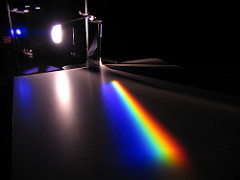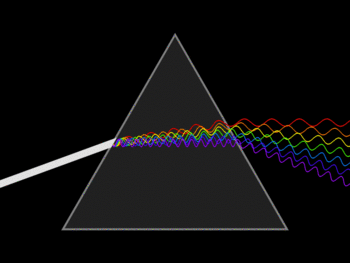MODULE: Colour perception
Step 02 of 09: Dispersion of light
Now we get to the classic figure of a single white light being separated out into the array of colours we as Designers are used to discussing in our rationale. We have Sir Isaac NEWTON to thank for this process called "Light dispersion" (or chromatic abberration/distortion) that best illustrates that white light is composed of a unified wavelength, but when it meets a denser medium through which it is refracted at different angles, it can exit at those angles as light travelling at different wavelengths.;

Refraction is one common waveform behaviour, alongside more common behaviours like reflection and light-scattering. While it is visibly clear enough what is occuring above (the incoming white light being stretched out into a broader band of coloured exiting lights), the underlying process that is resulting in colour is best illustrated in this animation showing the wavelengths instead. The "rainbow" we see above is the dissection of one unified (white) wavelength into many separate wavelengths, each seen as a colour;

So outside, in the real world, according to a physics-rooted explanation we understand that colour is light, travelling at a specific wavelength, and that the differences between colours are a difference in their frequency. Given that in the previous Module: Anatomy of the Eye we arrived at an understanding that the retina absorbs light through photo-receptive cells called rods and cones, we should now revisit that anatomy to understand how this differing-wavelength-light in the physical world becomes colours we see in objects and surfaces via our visual perceptive system.